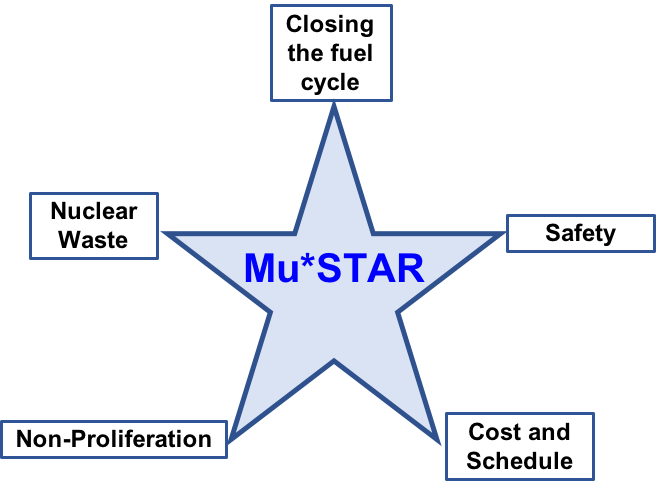| Top | Many Advantages | How It Works | Technology: System | Technology: Accelerator | Technology: Reactor |

| Mu*STAR addresses six big-picture issues:
|
Closing the fuel cycle: by converting what was "nuclear waste" into fuel and "burning" it, while greatly reducing the radio-toxic lifertime of the ultimate waste, Mu*STAR makes it feasible to bury the final waste on site, completing the cycle from earth to earth.
Nuclear waste: a fleet of Mu*STAR systems could reduce the amount and radio-toxic lifetime of nuclear waste to the point that it is no longer a terrible legacy left for 1,000 generations. This also has the potential to avoid transporting highly radioactive waste, and bypass the political impasse of Yucca Mountain. This enables all types of nuclear power, because many jurisdictions now prohibit any new nuclear plants until there is a sensible approach to dealing with the nuclear waste.
Safety: while nuclear power has the fewest number of deaths per gigawatt hour of all electricity-generating technologies, public perception has been strongly influenced by a few major accidents. Subcritical operation gives Mu*STAR significantly larger safety margins, and the combination of its molten-salt fuel and continuous removal of volatile fission products makes the release of radioactive elements into the environment possible only very locally within the plant site, and then only in the most overwhelming accident scenarios. The molten-salt fuel solidifies immediately for any leak, and thus does not flow; it is highly stable and does not react with or dissolve in water. Note also that Mu*STAR is a radical new design in which the root-cause components of all major reactor accidents are simply not present (water, steam, fuel rods, zirconium cladding, criticality excursions, spent fuel pools, and high-pressure vessels).
Non-proliferation: Mu*STAR does not need either uranium enrichment or fuel reprocessing, which are the primary pathways for weapons proliferation. This is due to the combination of subcritical operation and being driven by an accelerator, which means that Mu*STAR can use low-reactivity fuels that other reactor technologies cannot. This includes the spent nuclear fuel from existing reactors, and also natural uranium and thorium; it can even consume unwanted weapons material.
Cost: The major cost of electricity generated by nuclear power is the up-front capital investment required. As Mu*STAR is a radical new approach, many of the costly defense-in-depth structures of conventional reactors are simply not needed. For example, it operates near atmospheric pressure and has neither water nor steam inside the reactor, so the large pressure-containment buildings of current reactors are not needed. In addition, modern manufacturing techologies will further reduce construction costs, and modern instrumentation and control interfaces will reduce staffing needs.
Schedule: The major components of Mu*STAR are the accelerator, the molten-salt reactor, and the balance of plant. All have been succesfully operated in past or current facilities. The innovation here is putting them together in a new way to burn nuclear waste while avoiding the root causes of historical accidents.